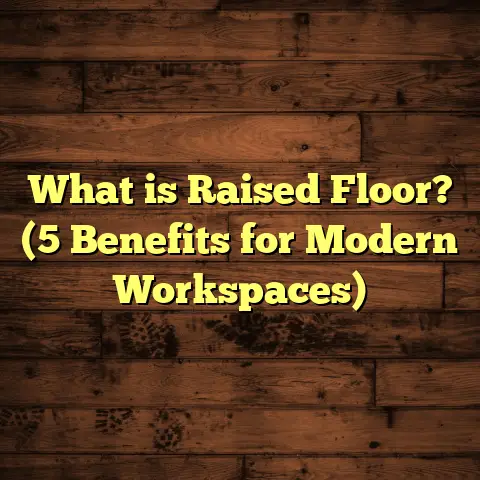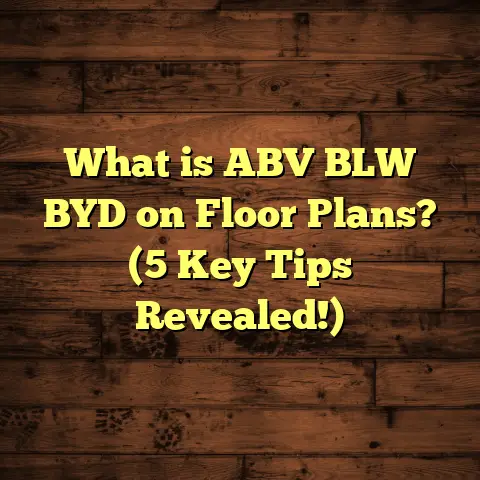What is a Floating Hardwood Floor Installation? (5 Steps to Easy DIY)
Spring is a perfect time to give your home a fresh look, and what better way than refreshing your floors? I remember last spring when I decided to replace the worn-out carpet in my living room. After years of pets and kids running around, the carpet had seen better days. I wanted something durable, stylish, and easy to install myself. That’s how I stumbled upon floating hardwood floors.
If you’re thinking about upgrading your flooring without the hassle of complicated installation, stick around. I’m going to walk you through what floating hardwood floor installation is and share five simple steps to help you do it yourself. Plus, I’ll share stories from my own projects, tips I learned the hard way, and data to help you make smart choices.
What Is Floating Hardwood Floor Installation?
If you’ve ever wondered, “What exactly does floating hardwood floor mean?” here’s the deal: floating hardwood floors don’t get nailed or glued down to the subfloor. Instead, the individual planks connect to each other and ‘float’ above the existing floor.
Think of it like a giant puzzle where each piece snaps into the next, but none are glued or nailed down. The whole floor rests on a layer called underlayment, which cushions it and helps with soundproofing.
Why Floating Floors?
Traditional hardwood flooring typically requires nailing or gluing planks to a plywood subfloor. This process can be time-consuming and tricky, especially if you’re not a professional. Floating floors simplify this by:
- Speeding up installation: No nails or glue means less prep and drying time.
- Allowing easier repairs: If one plank gets damaged, you can replace it without ripping up the whole floor.
- Accommodating subfloor types: You can install floating floors over concrete slabs, vinyl, or even old tile.
- Handling wood expansion: Wood naturally expands and contracts with humidity. Floating floors allow movement without buckling.
How Floating Floors Work
The tongue-and-groove edges of each plank lock together securely, creating a solid surface that behaves like one big piece of wood.
Underneath this floating “platform” is an underlayment layer. This layer is usually foam or cork and has several functions:
- Cushioning: Makes walking more comfortable.
- Sound absorption: Reduces noise when you walk.
- Moisture barrier: Some underlayments block moisture coming from below.
My First Encounter with Floating Hardwood Floors
When I first took on my flooring project last year, I was a bit nervous. I didn’t know much about hardwood or how to install it properly. But after watching videos and reading forums, I realized floating floors are incredibly forgiving.
One funny thing I remember was when I accidentally cut a plank too short. Instead of panicking, I improvised by using the leftover piece in a corner where it was barely visible. The modular nature of floating floors made this possible — you just can’t do that with nailed-down wood!
Why Choose Floating Hardwood Floors?
You might ask, “Is floating hardwood right for me?” Here’s why it worked well for my home and might for yours:
1. Installation Speed
Since there’s no glue or nails involved, installation took me just two days for my roughly 300 square foot living room.
Usually, for traditional hardwood floors, you’re looking at several days, including drying times for adhesives or nail-down steps.
2. Subfloor Flexibility
I installed mine on top of existing vinyl tiles in my basement — no need to rip anything out first.
Floating floors can go over concrete slabs, plywood, vinyl, or even ceramic tile as long as the surface is smooth and level.
3. Expansion and Contraction
Wood reacts to humidity changes by expanding or contracting. Floating floors allow each plank to move slightly without causing warping or buckling.
This is especially important if your home experiences seasonal humidity swings like mine did — in summer, my floors expanded slightly but never buckled.
4. Cost-Effectiveness
I saved a lot by doing the work myself and choosing floating floors. Materials usually cost between $4 to $8 per square foot, which is generally less than traditional hardwoods that require extra adhesives and labor.
If you hired a professional for traditional wood floors, you could be paying $8 to $12 per square foot just for installation alone.
5. Easy Repairs
Pets and kids often mean scratches or dents on floors. With floating floors, if one plank gets damaged, you can simply unlock and replace it without pulling up the whole floor.
My Flooring Project: A Personal Story with Data
Before starting, I measured my living room at around 300 square feet. I wanted solid oak engineered hardwood with a click-lock system, which is popular for floating installations.
Using local pricing data, materials were about $6 per sq ft. With installation costs factored in for professionals (if I hired one), the total would have been around $3,000-$3,600.
By doing it myself, I spent closer to $1,900 all-in including tools, underlayment, and trim pieces.
Time Spent
- Day 1: Prepping the subfloor and laying underlayment.
- Day 2: Installing planks.
- Day 3: Adding trim and finishing touches.
That was manageable on weekends over two weeks.
5 Steps to Easy DIY Floating Hardwood Floor Installation
Now that you know what floating hardwood floors are and why they’re great, here’s how you can install them yourself in five steps.
Step 1: Prepare the Room and Subfloor
Clear everything out of the room completely — furniture, rugs, baseboards — everything.
Clean thoroughly with a broom or vacuum.
Check the subfloor for any damage like cracks or bumps. Even small uneven spots can cause problems later.
Use a leveling compound or sand down raised areas. I used a hand sander on some bumps in my floor — made a big difference!
After leveling, sweep again to remove dust.
Why Preparation Matters So Much
I learned this the hard way when I installed my first floating floor in a less-than-perfect room. Small bumps caused some planks to pop up slightly, and I had to re-do sections because they didn’t lock properly.
Taking time at this stage saves headaches later on.
Step 2: Acclimate Your Flooring Material
Wood reacts to temperature and humidity changes. To avoid gaps or warping later on, let your wood planks sit in the room where they’ll be installed for at least 48 hours. Some manufacturers recommend up to 72 hours.
What Happens if You Skip Acclimation?
When I rushed this step once, I noticed small gaps appeared between planks a few weeks later. The wood had shrunk slightly as it adjusted to indoor humidity levels after being stored in a cold garage.
Taking this simple step prevents costly problems down the line.
Step 3: Plan Your Layout
Measure your room carefully — length, width, any irregular shapes like closets or doorways.
Decide which direction to lay the planks. I chose to lay mine parallel to the longest wall because it makes the room feel more spacious.
Stagger Your Joints
Use a staggering pattern where end joints between rows are offset by at least 6 inches. This strengthens the floor structurally and looks more natural.
Leave Expansion Gaps
Use spacers along all walls to leave about a 1/4 inch gap for expansion. This gap allows wood to swell slightly during humid months without buckling.
Step 4: Install the Flooring Planks
Start laying planks along your chosen wall, clicking them together as you go. Floating floors use a click-lock system—angle one plank into another and press down until they snap securely.
For tight fits, use a tapping block and rubber mallet gently, to avoid damaging plank edges while ensuring snug connections.
Cutting Planks
At doorways or edges where full planks won’t fit, measure carefully and cut planks with a jigsaw or handsaw.
I found marking cuts twice before cutting helped avoid mistakes.
Tips for Smooth Installation
- Work row by row.
- Periodically check that rows remain straight using a level.
- Keep spacers in place until all planks are installed.
- Take breaks if you get tired; rushing leads to errors.
Step 5: Finish Up with Trim and Clean-Up
Once all planks are laid, remove spacers from around walls. Install baseboards or quarter-round trim along edges to cover expansion gaps.
Why Trim Matters
Trim hides gaps while allowing wood movement underneath. I nailed trim directly into walls but avoided nailing it down into flooring itself. This keeps the floor free to expand without causing damage.
Cleaning Your New Floor
Sweep or vacuum dust and debris gently. Use manufacturer-approved cleaners sparingly — avoid soaking wood with water. A damp mop works best for regular cleaning.
How FloorTally Helped Me Manage Costs and Materials
Before buying anything, I wanted clarity on how much wood and other materials I’d need. That’s where FloorTally came in handy.
With this online tool, I input my room dimensions, chose my preferred hardwood type, and included expected waste percentage from cutting scraps (usually around 7-10%).
FloorTally gave me:
- Material quantity needed (including extra for waste)
- Estimated costs based on local prices
- Comparisons between different wood species
- Labor costs (if hiring pros)
- Budget breakdown by material type
Using FloorTally saved me from:
- Overbuying (which wastes money)
- Underbuying (which causes delays waiting for more materials)
- Guesswork around costs, making budgeting easier
I found this especially useful since prices fluctuate seasonally and regionally — FloorTally pulls local data so estimates stay accurate within my area.
More Tips from My Experience
Here are some lessons I picked up that might save you time:
- Always use spacers! They’re small but critical.
- Invest in decent tools: A rubber mallet, tapping block, good saws make installation easier.
- Work near natural light: It helps spot gaps or color inconsistencies early.
- Keep humidity stable during install: Use humidifiers/dehumidifiers if needed.
- Don’t rush: Take breaks; fatigue causes mistakes.
- Practice cutting scraps first: Get comfortable before cutting your actual planks.
- Wear knee pads: You’ll be on your knees a lot!
- Label your boards if they have directional grain patterns — helps keep consistent flow visually.
- Keep leftover planks for future repairs if needed.
Durability and Maintenance of Floating Hardwood Floors
You might wonder how well these floors last over time with normal wear and tear.
From my experience and research:
- Floating hardwood floors hold up well with regular care.
- Sweeping weekly keeps dirt grit from scratching surfaces.
- Avoid soaking with water; use damp (not wet) mops only.
- Choose harder woods (like oak, hickory, maple) if you expect heavy traffic or pets.
- Protective finishes can add scratch resistance but may need recoating every few years depending on wear.
- If damage occurs, individual planks can often be replaced easily without ripping up whole rooms.
My floor has survived two years now with kids running around, and only minor surface scratches that blended into natural wood grain patterns.
Common Questions About Floating Hardwood Floors
Q: Can floating floors be installed in basements?
A: Yes! They’re actually ideal since they can be installed over concrete slabs with moisture barriers underneath.
Q: Can I install floating floors over radiant heating?
A: Many engineered floating floors work well with radiant heat; check manufacturer specs first. Solid hardwood generally isn’t recommended over radiant heat due to expansion issues.
Q: How thick should floating floor planks be?
A: Most range from 8mm to 12mm thick. Thicker boards offer better durability but may cost more. My choice was 10mm which balanced cost and comfort well.
Q: Can floating floors be sanded/refinished?
A: Engineered hardwood can usually be lightly sanded once or twice depending on veneer thickness. Solid hardwood generally isn’t sanded if installed floating since it’s thinner than nailed-down wood flooring.
Q: What about sound? Are floating floors noisy?
A: Floating floors can be slightly noisier than glued/nail-down floors but underlayment reduces noise significantly. I used cork underlayment which made walking feel soft and quiet.
Comparing Floating Floors To Other Flooring Options
Let’s quickly compare floating hardwood floors against other common types:
| Flooring Type | DIY Installation | Cost per Sq Ft | Durability | Maintenance | Best For |
|---|---|---|---|---|---|
| Floating Hardwood | Easy | $4 – $8 | High | Sweep/damp mop | Living rooms/basements |
| Traditional Hardwood | Difficult | $8 – $15 | Very High | Sweep/mop/refinish | Formal rooms |
| Laminate Flooring | Easy | $2 – $5 | Medium | Sweep/damp mop | Budget-friendly projects |
| Vinyl Plank Flooring | Easy | $2 – $7 | High | Sweep/mop | Kitchens/bathrooms |
| Carpet | Moderate | $3 – $10 | Low | Vacuum | Bedrooms |
| Tile | Difficult | $5 – $15 | Very High | Mop | Bathrooms/kitchens |
Floating hardwood combines ease of installation with natural wood aesthetics better than laminate or vinyl, plus offers better warmth than tile — making it great for many living spaces.
Wrapping It Up with Some Final Thoughts
Choosing floating hardwood flooring means you get style, durability, ease of installation, and flexibility for future repairs or changes.
The five-step process I outlined—preparing your space, acclimating materials, planning layout, installing planks carefully, and finishing with trim—can turn anyone into a confident DIYer.
Planning with tools like FloorTally helped me avoid surprises in budgeting and material purchases. It gave me peace of mind going into my project knowing exactly what I needed in terms of quantity and cost—something every DIYer should consider before starting any big project like this.
After completing my floor last spring, every day reminded me why taking on this project was worth it—not just for looks but also comfort underfoot and satisfaction from doing it myself.
If you decide to take on floating hardwood floor installation yourself, remember patience pays off—you’ll have beautiful floors that last years to come!
Ready to start? Grab your measuring tape and tools — your dream floor awaits!
Would you like me to add detailed instructions on cutting techniques, tool recommendations, or advanced maintenance tips next?





